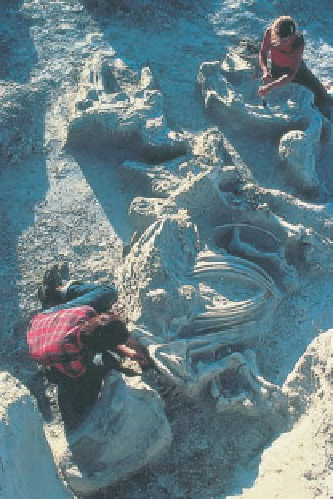Geology Reference
In-Depth Information
Paleontologists from the Univer-
sity of Nebraska have recovered or
left exposed for viewing the skeletons
of hundreds of victims of this pre-
historic catastrophe (
show signs of partial decomposition,
scavenging, and trampling before they
were buried.
Soon after the initial ash fall, the
depression was visited by herds of rhi-
noceroses and a few horses and camels.
These animals also died as their lungs
fi lled with ash, and then they were
buried quickly, as indicated by the
large number of complete skeletons.
One of the most remarkable things
about the fossils is the preserved detail.
According to Michael Voorhies of the
University of Nebraska, “Rarely found
parts such as tongue bones, cartilages,
tendons, and tiny bones in the middle
ear all survive in exquisite detail and in
their correct positions.”*
Only rarely are paleontologists
fortunate enough to fi nd and recover
so many, well-preserved, associated
vertebrate animals. A Late Miocene
catastrophe turns out to be our good
fortune because it provides us with a
unique glimpse of what life was like in
Nebraska 12 million years ago.
Figure 2). The
site is now Ashfall Fossil Beds State
Historical Park. The magnitude of the
ash-producing eruption is diffi cult to
imagine, because the ash cloud prob-
ably came from at least 1000 km away.
We know from historic eruptions
that ash can indeed be carried this
far. For example, during the April
11, 1815, eruption of Tambora in
Indonesia, an ash layer 22 cm thick
accumulated 400 km to the west, and
some ash fell more than 1500 km
from the volcano.
The initial ash fall was likely no
more than 30 to 60 cm deep, but as
it was redistributed by the wind, it
accumulated in some areas to about
3 m thick. From the geologic evidence
at the site, the area with the most
fossils was probably a low area with a
water hole at which animals congregated.
Many animals, including three-toed
horses, camels, deer, turtles, and birds,
perished here, and their skeletons
◗
◗
Figure 2
Paleontologists excavating
fossil horses (foreground) and rhinoceroses
from the 12-million-year-old ash.
lungs were damaged and they started
to die. Nothing disturbed the carcasses
except scavengers, and they were bur-
ied as wind-blown ash covered the
remains.
*“Ancient Ashfall Creates a Pompeii of Pre-
historic Animals,”
National Geographic
, 159,
no. 1:69, 1981.
some exceptionally large forms that lived in the warm wa-
ters of the Cenozoic Tethys Sea. Shells of these larger fora-
minifera accumulated to form thick limestones, some of
which were used by the ancient Egyptians to construct the
Pyramids of Giza.
The corals, having relinquished their reef-building
role to the rudists during the mid-Cretaceous, again be-
came the dominant reef builders during the Cenozoic.
Other suspension feeders such as bryozoans and crinoids
were also abundant and successful during the Cenozoic.
Perhaps the least important of the Cenozoic marine inver-
tebrates were the brachiopods, with fewer than 60 genera
surviving today.
Just as during the Mesozoic, bivalves and gastropods
were two of the major groups of marine invertebrates, and
they had a markedly modern appearance. Following the ex-
tinction of the ammonites and belemnites at the end of the
Cretaceous, the Cenozoic cephalopod fauna consisted of
nautiloids and cephalopods lacking shells, such as squids and
octopuses.
The echinoids continued their expansion in the infaunal
habitat and were particularly prolifi c during the Cenozoic.
New forms such as sand dollars evolved during this time
from biscuit-shaped ancestors.
During the Cenozoic, angiosperms continued to diversify,
although seedless vascular plants and gymnosperms were
also present in large numbers. In fact, many Paleogene
plants would be familiar to us today, but their geographic
distribution was not what it is now, because changing cli-
matic conditions along with shifting plant distributions
were occurring.
The makeup of ancient fl oras and the types of leaves
are good climatic indicators. Some plants today are con-
fi ned to the tropics, whereas others have adapted to drier
conditions, and we have every reason to think that climate
was a strong control on plant distribution during the past.
Furthermore, leaves with entire or smooth margins, many
with pointed drip-tips, are dominant in areas with abun-
dant rainfall and high annual temperatures. Smaller leaves
with incised margins are more typical of cooler, drier areas
(
◗
Figure 23.18a).


Search WWH ::

Custom Search